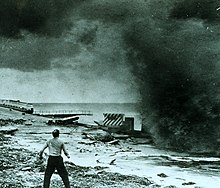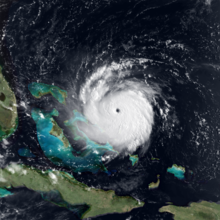|
List of Florida hurricanes
 Approximately 500 tropical and subtropical cyclones have affected the state of Florida. More storms hit Florida than any other U.S. state,[1] and since 1851 only eighteen hurricane seasons passed without a known storm impacting the state. Collectively, cyclones that hit the region have resulted in over 10,000 deaths, most of which occurred prior to the start of hurricane hunter flights in 1943. Additionally, the cumulative impact from the storms has totalled over US$300 billion in damage (2018 dollars), primarily from Hurricane Andrew, Hurricane Irma and Hurricane Ian in the 1992, 2017, and 2022 seasons respectively. The most recent hurricane to make landfall in Florida was Hurricane Milton in 2024. ClimatologyTropical cyclones have affected Florida in every month of the year with the exceptions of January and March. Nearly one-third of the cyclones affected the state in September, and nearly three-fourths of the storms affected the state between August and October, which coincides with the peak of the hurricane season. Portions of the coastline have return periods, or expected time between hurricane strikes of a certain intensity or category within 86 miles (138 km) of a given location, that are the lowest in the country. Monroe County was struck by 26 hurricanes since 1926, which is the greatest total for any county in the United States.[2] In a Monthly Weather Review paper published in 1934, the U.S. Weather Bureau recognized Key West and Pensacola as the most hurricane-prone cities in the state; Key West experiences both storms developing from the western Atlantic Ocean and the Caribbean, while Pensacola has received hurricanes crossing the state as well as storms recurving in the northern Gulf of Mexico.[3] Officially, the earliest hurricane to affect the state was Hurricane Alma on June 9; the latest, Hurricane Kate on November 21. However, preliminary reanalysis suggests that a hurricane may have struck the state on May 28, 1863.[4] The strongest tropical cyclone to make landfall on the state was the 1935 Labor Day hurricane, which crossed the Florida Keys with a pressure of 892 millibars (26.3 inHg); it is also the strongest hurricane on record to strike the United States. Out of the ten most intense landfalling United States hurricanes, four struck Florida at peak strength.[5] Pre-1900 The first recorded tropical cyclone to affect the area that is now the state of Florida occurred in 1523, when two ships and their crews were lost along the western coastline.[6] A total 159 hurricanes are known to have affected the state prior to 1900, which collectively resulted in at least 6,504 fatalities and monetary damage of over $102 million (2017 dollars). Additionally, at least 109 boats or ships were either driven ashore, wrecked, or damaged due to the storms. A strong hurricane struck northwest Florida on May 28, 1863, and is the earliest landfall during the year known in the US, pending reanalysis.[4] Information is sparse for earlier years due to limitations in tropical cyclone observation, though as coastlines became more populated, more data became available. The National Hurricane Center recognizes the uncertainty in both the death tolls and the dates of the events.[7] 1900–1949 In the period between 1900 and 1949, 108 tropical cyclones affected the state, which collectively resulted in about $4.5 billion (2017 dollars) in damage. Additionally, tropical cyclones in Florida were directly responsible for about 3,500 fatalities during the period, most of which were from the 1928 Okeechobee hurricane, the state's deadliest. The 1947 season was the year with the most tropical cyclones affecting the state, with a total of six systems. The 1905, 1908, 1913, 1927, 1931, 1942, and 1943 seasons were the only years during the period in which a storm did not affect the state. The strongest and most intense hurricane to hit the state during the period was the 1935 Labor Day hurricane—the most potent on record to strike the United States. Collectively this storm, the 1926 Miami hurricane, and the 1928 hurricane claimed over 3,280 lives in Florida—three of the state's 10 most impactful weather events in the 20th century; the 1926 storm would be the costliest of any U.S. hurricane in present monetary values. Hurricane-wise the 1940s were among the state's busiest decades: 11 hurricanes struck from 1944–50, six of them major, including five Category 4 hurricanes in South Florida. Storms catalyzed development: impacts radiated societally, broaching complex political and socioeconomic topics, and lead to epochal changes such as flood control and building codes.[8][9] 1950–1974 In the period between 1950 and 1974, 85 tropical or subtropical cyclones impacted the state, which collectively resulted in about $7 billion (2017 dollars) in damage, primarily from Hurricanes Donna and Dora. Additionally, the storms were directly responsible for 93 fatalities and indirectly for 23 more deaths. Several tropical cyclones produced over 20 inches (500 mm) of rainfall in the state, including Hurricane Easy, which is the highest total during the period. The 1969 season was the year with the most tropical cyclones affecting the state, with a total of eight systems. The 1954 and 1967 seasons were the only years during the period in which a storm did not affect the state. The strongest hurricane to hit the state during the period was Hurricane Donna, which was the tenth strongest hurricane on record to strike the contiguous United States.[10][5] Additionally, Hurricanes Easy, King, Betsy, and Alma hit or otherwise impacted the state as major hurricanes. 1975–1999 In the period between 1975 and 1999, 83 tropical or subtropical cyclones affected the state, which collectively resulted in $51.1 billion (2017 dollars) in damage, primarily from Hurricane Andrew, and 54 direct casualties. The 1985 season was the year with the most tropical cyclones affecting the state, with a total of eight systems. Every year included at least one tropical cyclone affecting the state. The strongest hurricane to hit the state during the period was Hurricane Andrew, which was one of only four Category 5 hurricanes to strike the United States. Andrew, at the time, was the costliest tropical cyclone in United States history and remains the seventh-costliest. Additionally, Hurricanes Eloise, Elena, and Opal hit or otherwise impacted the state as major hurricanes. 2000–present The period from 2000 to the present has been marked by several devastating North Atlantic hurricanes; as of 2023[update], 79 tropical or subtropical cyclones have affected the U.S. state of Florida. Collectively, cyclones in Florida over that period resulted in over $236 billion in damage, most of it from Hurricane Ian.[11] Additionally, tropical cyclones in Florida were responsible for 145 direct fatalities and at least 92 indirect ones during the period. Eight cyclones affected the state in both 2004 and 2005, which were the years with the most tropical cyclones impacting the state. Every year included at least one tropical cyclone affecting the state. The strongest hurricane to hit the state during the period was Michael, which made landfall in Florida as a Category 5 hurricane–the strongest since Andrew in 1992. Additionally, nine other hurricanes made landfall on or otherwise impacted the state as major hurricanes. Florida major hurricanesThe following major hurricanes either made landfall on the state as a major hurricane or brought winds of Category 3 status to the state. For storms that made landfall twice or more, the maximum sustained wind speed, and hence the highest Saffir–Simpson category, at the strongest landfall is listed. Only landfalls at major hurricane intensity are listed. Storms are listed since 1851, which is the official start of the Atlantic hurricane database.[5][9] Originally, hurricanes were classified by central pressure in the 20th century;[9][12] however, modern practices quantify storm intensities by maximum sustained winds.[13] United States hurricanes are still classified by central pressure from 1971 to 1979;[9][14] therefore, the maximum sustained winds in the Atlantic hurricane database (HURDAT) are utilized for storms from 1971 to 1979,[5] since this period has not been reanalyzed by the Atlantic hurricane reanalysis project.[15]
Strongest and most intense
"Great", "Major", and "Extreme" hurricanesSaffir–Simpson rankings were given United States storms beginning in 1975,[13] first on the basis of pressure,[12] then on wind alone since the late 1980s;[13] informal metrics gauged intensity prior. A "Great Hurricane" contained winds over 125 mph (200 km/h) and spread hurricane-force winds over 100 miles (160 km) or more, while also generating high tides, low pressures, extensive damage, and casualties.[17] A "Major" hurricane featured winds of 101–135 mph (163–217 km/h) and a barometric pressure of 28.01 to 29.00 inHg (949 to 982 mb); an "Extreme" hurricane, at least 136 mph (219 km/h)—roughly equivalent to Category 4 on the Saffir–Simpson scale—and 28.00 inHg (948 mb) or lower.[18] From 1880–1960 the following Florida storms have been classified as "Great", "Major", and/or "Extreme":
Monthly statistics
Deadliest storms
See alsoWikimedia Commons has media related to Effects of hurricanes in Florida.
References
Further reading
|
|||||||||||||||||||||||||||||||||||||||||||||||||||||||||||||||||||||||||||||||||||||||||||||||||||||||||||||||||||||||||||||||||||||||||||||||||||||||||||||||||||||||||||||||||||||||||||||||||||||||||||||||||||||||||||||||||||||||||||||||||||||||||||||||||||||||||||||||||||||||||||||||||||||||||||||||||||||||||||||||||||||||||||||||||||||||||||||||||||||||||||||||||||||||||||||||||||||||||||||||||||||||||||||||||||||||||||||||||||||||||||||||||||||||||||||||||||||||||||||||||||||||||||||||||||||||||||||||||||||||||||||||||||||||||||||||||||||||||||||||||||||||||||||||||||||||||||||||||||||||||||||||||||||||||||||||||||||||||||||||||||||||||||||||||||||||||||||||||||||||||||||||||||||||||||||||||||||||||||||||||||||||||||||||||||||||||||||||||||||||||||||||||||||||||||||||||||||||||||||||||||||||||||||||||||